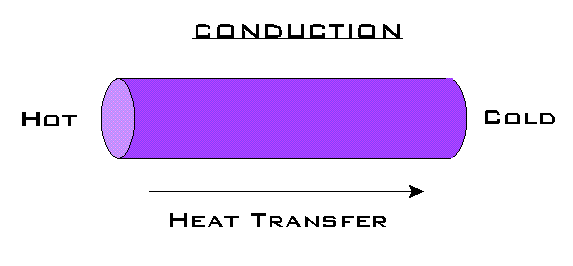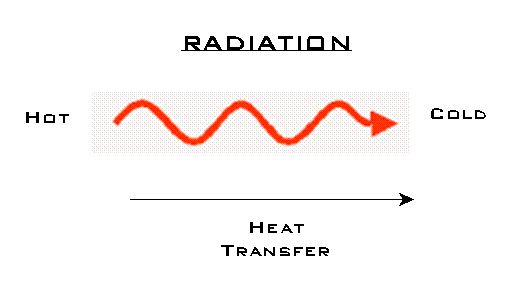vThe Energy Story
The Energy Problem
The Energy Solution
Conserving
Electricity
Appliance
Efficiency
Heating
Conservation
Renewable
Energy |

|
Heating
Conservation
|
|
There
are three basic forms of heat transfer that can cause your
home to lose heat in the winter or gain heat in the summer.
|
|
Conduction
|
|
In conduction
the heat energy is transferred without the movement of any
substance. The heat energy moves along or across an object
or substance. For example, when you place an iron pan on the
range or oven and heat it up, you know that the handle can
get hot. The heat energy from the oven burner is transferred
to the bottom of the pan and through the pan to the handle
by conduction.
The rapid motion of the molecules at the hot end of the object
and collisions with the colder slower moving molecules to
the right, cause these molecules to move faster and increase
their temperature. This process continues, with the temperature
of the object increasing from the left side to the right side.
This transfer of heat energy from the left to the right through
the object is called conduction.
|
|
Convection
|
|
In convection
the transfer of heat energy is caused by the flow of a fluid,
most commonly air or water. The hotter fluid tends to be less
dense and therefore rise, causing what are called convection
currents. The hot air will rise in one part of the room, forcing
the cooler air above to fall in another part of the room.
The net result is a transfer of heat energy, again from the
hotter fluid to the colder fluid. This is how the heating
system in your home transfers the energy into the house. Whether
the heating is done by hot water that is circulating in pipes
or hot air that is circulating in ducts, the temperature in
each room is increased (or decreased) by the convection currents.

|
|
Radiation
|
|
The transfer
of heat or energy that requires neither an object or a flow
of a fluid is radiation. In radiation heat transfer the energy
is moved by the changing of heat energy into light energy
or light energy into heat energy. A burning fire is one example.
Certainly, the fire will heat the air and cause heat transfer
by convection. But much of the chemical energy released by
the burning of the wood or whatever fuel is being used will
be changed into light energy. When this light energy, probably
in the infrared frequency, hits you or surrounding objects,
it is changed into heat energy.

|
|
|
|
|